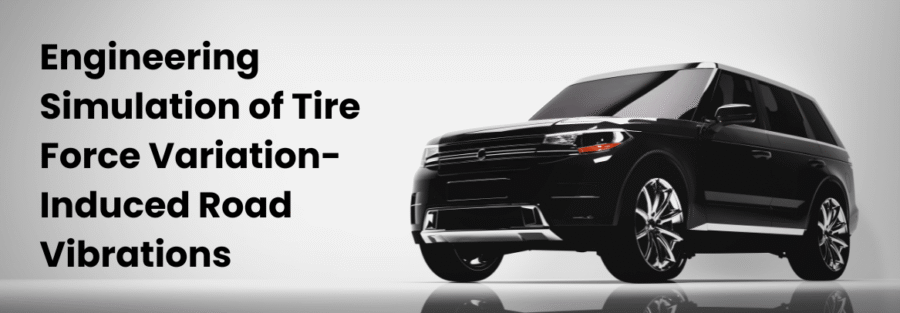Tire force variation induced by road surface irregularities, tire nonuniformity, and operational conditions can trigger complex vibrations in automotive systems, influencing ride comfort, NVH (Noise, Vibration, Harshness), and long-term durability. Leveraging engineering simulation—especially Multi-Body Dynamics (MBD) modeling with flexible body representations—enables engineers to analyze, predict, and mitigate these adverse effects with high precision.
At Caliber Technologies LLC, our engineering team employs a simulation-driven approach to identify, quantify, and mitigate the effects of tire force variation through an integrated multi-body dynamics (MBD) and flexible structural analysis framework. This approach combines ADAMS/Car-based dynamic modeling with Finite Element (FE)-based flexible body representations, enabling high-fidelity prediction of road-induced vibrations and effective countermeasure development.
Engineering Simulation Approach
Modeling Tire Force Variation
Tire force variations—generated by irregular tread and sidewall stiffness, out-of-roundness, or lane-level undulations—are primary excitations responsible for steering wheel vibrations (“nibble”), seat shake, and structure-borne noise. To accurately capture these phenomena, simulation begins with:
- A detailed nonuniform tire model reproducing periodic and random force outputs at the contact patch.
- Input of realistic road profiles—random and impulse—covering highway and bump scenarios.
Multi-Body Dynamics (MBD) with Flexible Bodies
Traditional MBD simulations treat vehicle components (control arms, subframe, chassis, seat, steering) as rigid bodies. However, true road vibration prediction demands incorporating flexibility—allowing critical components to deform dynamically under load. The process involves:
- Rigid-Flexible Coupling: Control arms, subframes, body, seat frames, and steering structures are digitized as flexible bodies using finite element meshing and reduced order modeling.
- System Integration: Components are assembled with bushings, joints, and mountings that mirror real-life constraints and compliance.
This hybrid approach enables the simulation to predict not just motion, but also stress, strain, and vibration transmission through the entire assembly.
Load Cascade and Vibration Transmission
When tire force variation excites the wheel end, loads propagate through the suspension (e.g., lower control arm), subframe, and onward to the chassis, steering column, seat tracks, and finally to the occupant. Key points include:
- Modal Coupling: Resonance can occur if the excitation frequency matches natural modes of any subsystem (e.g., steering system, seat frame), amplifying perceived vibration.
- Structural Damping and Compliance: Flexible structures, especially subframes and bushings, absorb and redistribute energy, changing vibration characteristics at each node.
Simulation Outputs and Engineering Insights
- Axial acceleration at the seat track, steering wheel, and body is predicted for both random and impulse road inputs, allowing direct assessment of ride comfort and NVH.
- Stress and life calculations for flexible components reveal durability risks, allowing targeted design improvements.
- Sensitivity analysis determines the effect of component stiffness, damping, mass, and mounting geometry on vibration transmissibility, guiding effective countermeasures for shaking and noise.
Simulation results are compared with experimental vehicle test data, ensuring model validity and providing actionable recommendations to improve overall vehicle performance.
Summary and Industry Application
Through advanced multi-body dynamics modeling with flexible structure representation, engineers:
- Accurately forecast and diagnose vibration phenomena tied to tire force variations
- Quantitatively assess design alternatives for control arms, subframes, seat structures, and steering
- Optimize placements and stiffness/damping characteristics to reduce NVH and improve occupant comfort
This systematic simulation methodology is essential for modern chassis engineering, resulting in vehicles that deliver superior ride quality and durability across diverse operating conditions.Tire force variation from road irregularities and tire nonuniformity triggers significant vibration through the suspension and steering systems, manifesting as steering nibble, seat shake, and structure-borne NVH issues. Advanced engineering simulation now employs multi-body dynamics (MBD) models, with flexible body representations of crucial structures (e.g., control arms, subframe, chassis, seat, steering column, and mounts), capturing not only rigid body motion but also local deformation, resonance, and damping effects.
In this framework, nonuniform tire forces are introduced as dynamic inputs driving a virtual vehicle model. Flexible component modeling via lumped-mass or reduced FE techniques allows the simulation to reveal amplified vibrations when excitation matches local or global modes—such as subframe bending, seat track oscillation, or steering wheel torsional resonance. Damping, stiffness, and geometry at each stage are tuned to minimize transmissibility and optimize ride comfort. This integrated simulation approach offers precise prediction, validation, and calibration against experimental data, supporting robust NVH mitigation and long-term durability improvements in modern automotive suspension and steering system design



